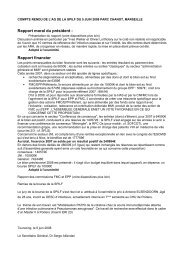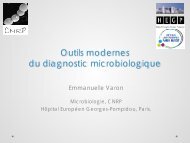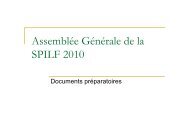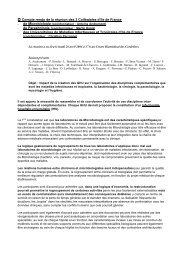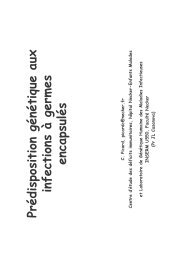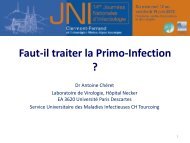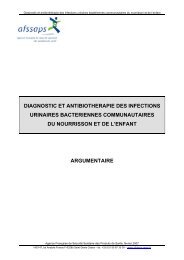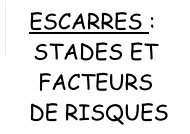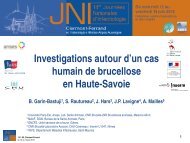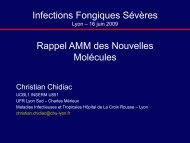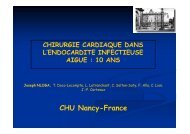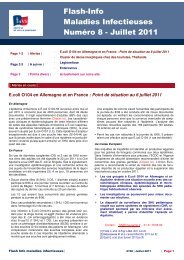Item n° 77 : Angines et rhinopharyngites de l'enfant et ... - Infectiologie
Item n° 77 : Angines et rhinopharyngites de l'enfant et ... - Infectiologie
Item n° 77 : Angines et rhinopharyngites de l'enfant et ... - Infectiologie
Create successful ePaper yourself
Turn your PDF publications into a flip-book with our unique Google optimized e-Paper software.
<strong>Item</strong> <strong>77</strong><br />
2-2-2. Signes fonctionnels<br />
• Obstruction nasale, éternuements, toux.<br />
• Rhinorrhée claire puis mucopurulente (ne signe pas une surinfection bactérienne <strong>et</strong> ne justifie pas d’antibiotique).<br />
• Douleurs pharyngées.<br />
• Parfois gastroentérite fébrile chez le nourrisson.<br />
2-2-3. Examen<br />
• Pharynx inflammatoire.<br />
• Écoulement nasal postérieur inconstant.<br />
• Adénopathies sous-digastriques chez l’enfant.<br />
• Tympans normaux ou congestifs chez l’enfant.<br />
II<br />
ARGUMENTER L’ATTITUDE THéRAPEUTIQUE ET PLANIFIER LE SUIVI DU PATIENT :<br />
ANGINES ET RHINOPHARYNGITES<br />
1. <strong>Angines</strong><br />
Fonction <strong>de</strong> l’aspect anatomoclinique.<br />
1-1. <strong>Angines</strong> érythémateuses <strong>et</strong> érythématopultacées<br />
1-1-1. Risque lié au SGA <strong>et</strong> à ses complications potentielles<br />
1-1-2. Traitement<br />
• Symptomatique : paracétamol.<br />
• Stratégie antibiotique<br />
--<br />
TDR négatif : angine présumée virale : traitement symptomatique ; paracétamol (adulte 1 g x 4 par jour ; enfant 15 mg/kg x 4 par jour).<br />
--<br />
TDR positif : angine streptococcique : antibiothérapie per os ; privilégier les traitements courts pour améliorer l’observance. Amoxicilline en première<br />
intention ; sinon céphalosporine orale. En cas d’allergie aux ß-lactamines, pristinamycine chez l’adulte, macroli<strong>de</strong>s chez l’enfant après prélèvement<br />
<strong>de</strong> gorge préalable (20 % <strong>de</strong> résistance du strepto A aux macroli<strong>de</strong>s).<br />
--<br />
Choix antibiotique : Cf. tableau T<strong>77</strong>-2.<br />
2-2. <strong>Angines</strong> pseudomembraneuses<br />
2-2-1. Mononucléose infectieuse<br />
• Repos, antipyrétique.<br />
• Corticothérapie si forme sévère ou compliquée.<br />
• Les aminopénicillines (amoxicilline) sont à proscrire car risque d’allergie (exanthème morbilliforme).<br />
• Il n’y a pas d’antiviral efficace sur EBV.<br />
2-2-2. Diphtérie<br />
• Urgence thérapeutique.<br />
• Nécessite prise en charge spécialisée (antibiotiques par ß-lactamines + sérothérapie).<br />
• Isolement respiratoire ; corticothérapie si laryngite.<br />
• Déclaration obligatoire à l’ARS.<br />
• Prophylaxie suj<strong>et</strong>s contacts.<br />
• La prévention repose sur la vaccination obligatoire chez l’enfant avec rappel chez l’adulte jeune.<br />
2-3. <strong>Angines</strong> vésiculeuses<br />
2-3-1. Herpangine<br />
• Traitement symptomatique.<br />
2-3-2. Primo-infection herpétique<br />
• Soins <strong>de</strong> bouche.<br />
• Aciclovir si forme sévère.<br />
• Réhydratation si nécessaire.<br />
2-4. <strong>Angines</strong> ulcéronécrotiques<br />
2-4-1. Angine <strong>de</strong> Vincent<br />
• Traitement symptomatique si nécessaire.<br />
• Antibiothérapie par pénicilline ou métronidazole si allergie.<br />
2-4-2. Chancre syphilitique amygdalien<br />
• Recherche <strong>et</strong> traitement du ou <strong>de</strong>(s) partenaire(s), recherche d’autres MST associées (VIH…).<br />
• Antibiothérapie par benzathine-pénicilline (2,4 M en 1 injection IM).<br />
Pilly - Préparation ECN - <strong>Item</strong> <strong>77</strong> - ©CMIT<br />
20



